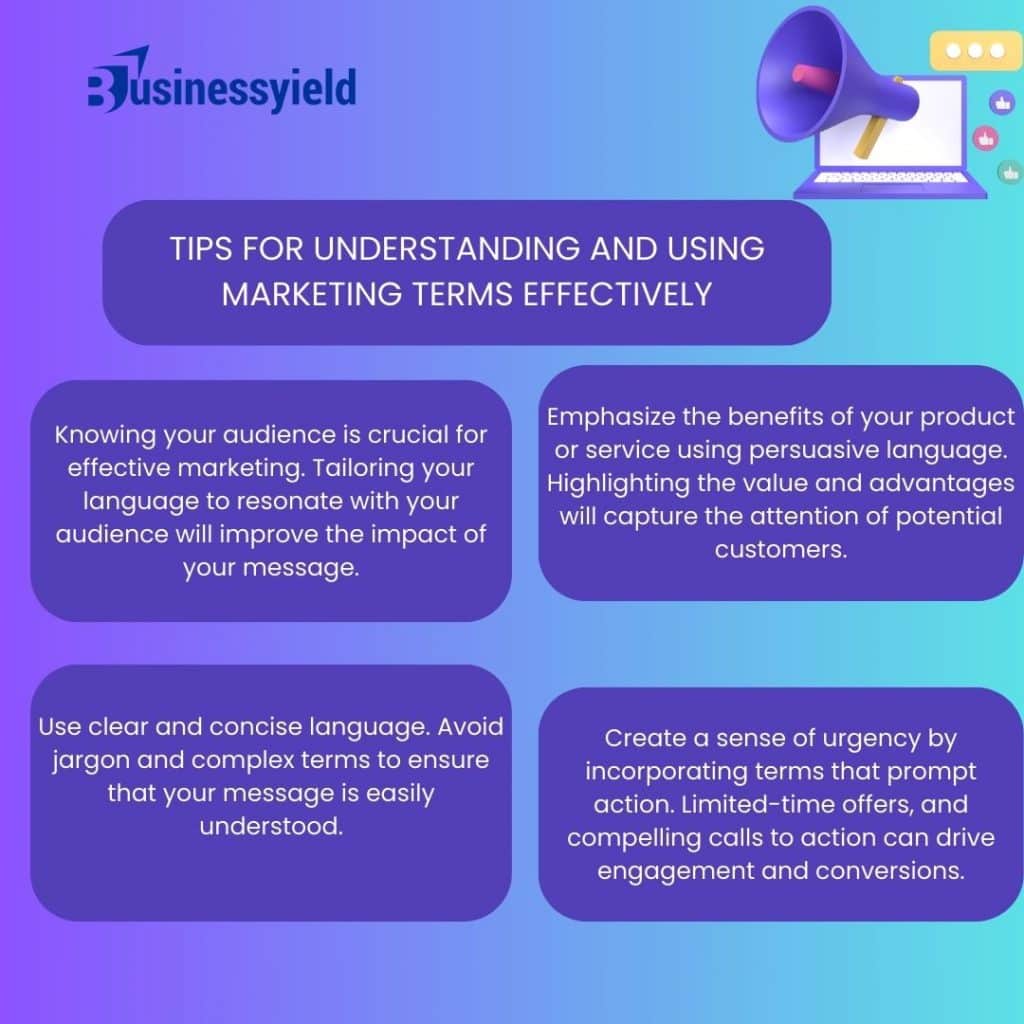To unlock online success and reach a global audience, you need to know what marketing and social media marketing are all about, and I am here to help you understand them better. So, let’s get started in the world of digital marketing and social media, where every term holds the potential to transform the way you connect with the world.
What is Marketing Terms
Marketing terms are words or phrases used to describe processes or activities within product or service marketing. These terms generally relate to creating, advertising, or providing a business’s offerings. Regardless of your position in an organization, understanding these terms can help you know a product’s position in the market and gain insight into critical performance metrics. Effective presentations at work may not cover these terms, so staying up-to-date on industry language is important. Here are the +35 essential marketing terms and the definitions every marketer should know:
#1. A/B testing
Marketing analysts use A/B testing to determine which option works better in a campaign.This method is often used in email campaigns, where the marketing team tests variations of the subject line to see which prompts more people to open or delete the email before reading it.
#2. Analytics
Analytics helps people discover current trends in an industry and how they might affect a business. They typically involve graphs and charts showing different data points to compare industry, product, service, and other data types. This information helps the marketing team allocate their advertising budget for the coming year.
#3. Business-to-business (B2B) marketing
B2B refers to a company that sells to other companies. For example, an architecture firm specializing in commercial buildings sells its services to a tenant in that building space.
#4. Business-to-consumer (B2C) marketing
B2C describes a company that sells to individual consumers. For instance, most retail stores are B2C as they sell their products directly to customers for consumption.
#5.Business blogging
Business blogging helps marketers reach a specific audience online by using particular keywords that a consumer might use to search for a business providing a specific product or service. Marketers aim to direct online traffic to their business blogs to generate new sales.
#6. Bounce rate
There are two types of bounce rates. A website bounce rate refers to the percentage of people who visit your website but need help to click or navigate to other areas of the website.
#7. Brand awareness
Brand awareness refers to marketing strategies that raise consumer awareness of a product or service. It also includes efforts to ensure consumers associate a company with positivity.
#8. Buyer persona
Marketers develop buyer personas based on research and data. These personas represent typical or ideal consumers using a product or service. This helps marketers develop strategies to reach the target market.
#9. Call to action (CTA)
A call to action is a link, image, or button that entices a potential consumer to purchase, subscribe, or perform another action that converts a visitor to your website into a sales lead. Examples of CTA include “subscribe now” or “download your free report.”
#10. Click-through rate
The click-through rate is the percentage of visitors to your website who move from one area of your website to another. These consumers click through various areas of your website, usually based on strategic marketing campaigns that guide the visitor to those specific areas.
#11. Hashtag
A hashtag is a word or phrase preceded by the “#” symbol and contains a string of words with no spaces. It’s commonly used on social media to initiate discussions or interactions about specific content. Users can follow hashtags to see what others have posted and shared.
#12. Inbound Marketing
Inbound marketing involves activities aimed at attracting potential customers to your website. Marketers create content based on customer interests to draw potential customers to their website and convert them into customers.
#13. Infographic
An infographic is a visual piece of content designed to simplify complex concepts.
#14. Key Performance Indicator (KPI)
Companies use key performance indicators to measure employee or marketing activities in the market. Marketers use KPIs to assess their performance against industry-standard metrics and track their progress toward their goals.
#15. Keyword
Keywords are words or phrases potential customers might use to search for your website. Search engines use these keywords to display the most relevant websites, posts, news articles, and more at the top of the search page.
#16. Landing Page
A landing page is a web page where an inbound link directs potential customers to generate leads.
#17. Lead
A lead represents a potential customer for a business. Companies generate leads by employing landing pages, calls to action, and other tools.
#18. Lead Nurturing
Lead nurturing involves developing a series of communications to engage potential customers and guide them through the sales funnel to make a purchase. This is typically done through email, social media messages, or other channels.
#19. Lifecycle Stages
Lifecycle stages represent the different stages potential customers go through. These stages can be divided into awareness, evaluation, and purchase, and the stage the lead is in may determine the type of relevant content.
#20. Marketing Automation
Marketing automation involves using specific platforms, tools, and analytics to automate lead nurturing. For example, a lead generated through a landing page may trigger a specific email to be sent using the platform or tools.

#21. Mobile Marketing
This type of marketing involves strategies to interact with consumers based on their location and promote specific goods or services to users searching from their smartphones.
#22. Mobile Optimization
Web designers use mobile optimization to format a company’s website so that users can easily navigate it using their mobile devices. Marketers often aim to implement mobile optimization into most platforms used to manage websites.
#23. Net Promoter Score (NPS)
NPS is a metric that indicates how likely customers are to recommend a company to others, using a scale of zero to 10. Companies use NPS scores to identify areas for improvement in their products or services.
#24. Newsfeed
A newsfeed displays the latest news, posts, images, and more on a homepage or other online source. Most social media platforms have a newsfeed.
#25. Churn rate
This metric represents the number of customers that a company has lost in any given period. Calculating this rate helps companies keep track of how many customers they’re retaining.
#26. Closed-loop marketing
This type of marketing includes the execution and tracking of marketing efforts, as well as the ability to show how they’ve impacted business growth or sales. Companies use this to determine if their marketing investments are working and help to guide marketing strategies going forward.
#27. Content
Content is the information on a team’s website, social media posts, blogs, videos, podcasts, or other outlets used to reach consumers. Businesses use content to engage with their consumers with the intent of the information being shared with potential customers.
#28. Conversion rate
The conversion rate is the percentage of people who take action from a landing page. For example, if you intend to create a contact list through an offer of a free report and 25 out of 100 people give you their contact information, then your conversion rate is 25%.
#29. Conversion rate optimization
This is the process of using marketing techniques like web design and social media campaigns to increase your conversion rate.
#30. Cost per lead
This is the amount a company spends to secure one lead. It’s a helpful indicator of whether your marketing strategies are effective.
#31. Customer relationship management
Customer relationship management refers to how companies
track their existing and potential customers. Some software programs track this information and provide support, such as sending out emails, scheduling appointments, and tracking every interaction with the customer.
#32. Digital Marketing

Credit:rawpixel
Digital marketing refers to marketing conducted over the internet, either through websites or ads placed online. You can access digital marketing through phones, computers, or any other means of connecting to the internet.
#33. Editorial calendar
An editorial calendar is a way to outline when to make specific content and where to place it. For example, on the Friday after Thanksgiving, an editorial calendar might show content being posted on social media as well as an email sent out to customers to shop on Black Friday for great deals.
#34. Engagement rate
Engagement rate is useful in relation to social media in describing users’ interaction with your content. Likes, shares, and comments on a social media post measure how users receive your content.
#35. Sales qualified lead (SQL)
Sales qualified lead (SQL) is the fourth stage in the buyer’s journey, following the MQL stage. It is recognized when sales and marketing agree that the contact has shown enough interest and suitability to initiate a sales conversation. This stage involves the handoff from marketing to sales and can be challenging to define. The average B2B sales cycle length is approximately 6-9 months.
#36. Conversation qualified lead
Conversation Qualified Lead (CQL) refers to someone who has expressed interest in making a purchase through a conversation with an employee or a bot. These leads seek real-time answers to specific questions.
#37. Buyer’s Journey
The buyer’s journey is the process a contact goes through, from recognizing a problem to making a purchase decision. It consists of the awareness stage, consideration stage, and decision stage. This journey differs from the customer journey, as not every prospective buyer becomes a customer.
#38. Multi-touch revenue attribution
Multi-touch revenue attribution involves organizing and documenting all interactions leading to a purchase decision. It helps businesses understand how marketing contributes to the company’s bottom line. Customer marketing encompasses strategies and tactics aimed at the existing customer base to enhance their experience with the brand and increase their engagement value. It aims to improve retention, advocate for the brand, and nurture existing customers for future sales.
Digital Marketing Terms
Digital marketing refers to techniques that leverage digital technologies, such as the Internet. This term encompasses online marketing practices, including SEO, CRO, PPC, blogging, web design, and content marketing, among other forms of online marketing.

Credit:rawpixel
Social media marketing terms are terminology you can use on social media platforms such as Twitter, Instagram, and Facebook, which have become standard practice for marketers. Whether a seasoned marketer or a beginner, working in marketing today needs social media. Social media terminology will help you decode digital jargon. If you’re an aspiring marketer or looking to advance your career, you must be familiar with social media marketing terms. Here are social media marketing terms:
- Clickthrough rate
- Conversion rate
- Clickbait
- Chatbot
- Algorithm
- Brand awareness
- Blog
- Crowdsourcing
Search engine optimization
Checklist-of-Common-Marketing-Terms
What Are the 4 As of Modern Marketing?
The 4 Aspects of modern marketing are acceptance, Accessibility, Affordability, and Awareness.
Acceptability: This is how well a product or service meets the needs and wants of the target market. It ensures that people want and value what you’re offering.
Accessibility: Accessibility is about making your product or service easy to find and obtain for your target customers. It involves considerations such as distribution channels, location, and ease of purchase.
Affordability: Affordability is about pricing your product or service in relation to its perceived value by the target market. It’s important to balance offering value and setting a price that customers are willing to pay.
Awareness: This involves ensuring your target market knows your product or service and its benefits. This can be achieved through various marketing and promotional efforts to increase visibility and recognition.
Also, Check out our article on Mastering the Marketing Mix: A Personal Journey
What Are the 4 PS of Marketing, and What Does Each Mean?
Place: This is where consumers purchase your product. They can buy it through smartphones, social media, or sales professionals.
Price: This is the cost of the product or services provided. It is the amount of money that customers have to pay to acquire the product or service.
Product: This depends on what the company can offer or do best. It may be based on the production model and remain consistent even as the company expands.
Promotion: This is what a company does to advertise its product or service to its customers. This includes advertising, public relations, sales promotions, personal selling, and other forms of marketing communication.
What Is the Basic Concept of Marketing?
The basic concepts of marketing include the production Concept, The Product Concept, The Selling Concept, The Marketing Concept, and The Societal Marketing Concept. The Production Concept emphasizes making products widely available and affordable, assuming consumers prioritize availability and low prices. The Product Concept focuses on offering high quality, performance, and innovative features, assuming that consumers appreciate well-made products. The Selling Concept assumes that consumers need to be persuaded to buy products through aggressive selling and promotion efforts. Finally, the Marketing Concept emphasizes the importance of creating, delivering, and communicating customer value to target customers more effectively than competitors.
- TEAM LEAD: Meaning, Duties, Interview Questions & Salary
- LOAN TERM: Definition, Types and How It Works
- STAGES OF THE EMPLOYEE LIFE CYCLE EXPLAINED!
- WHAT IS MARKETING CONCEPT: Meaning, Examples, Types & Strategy






